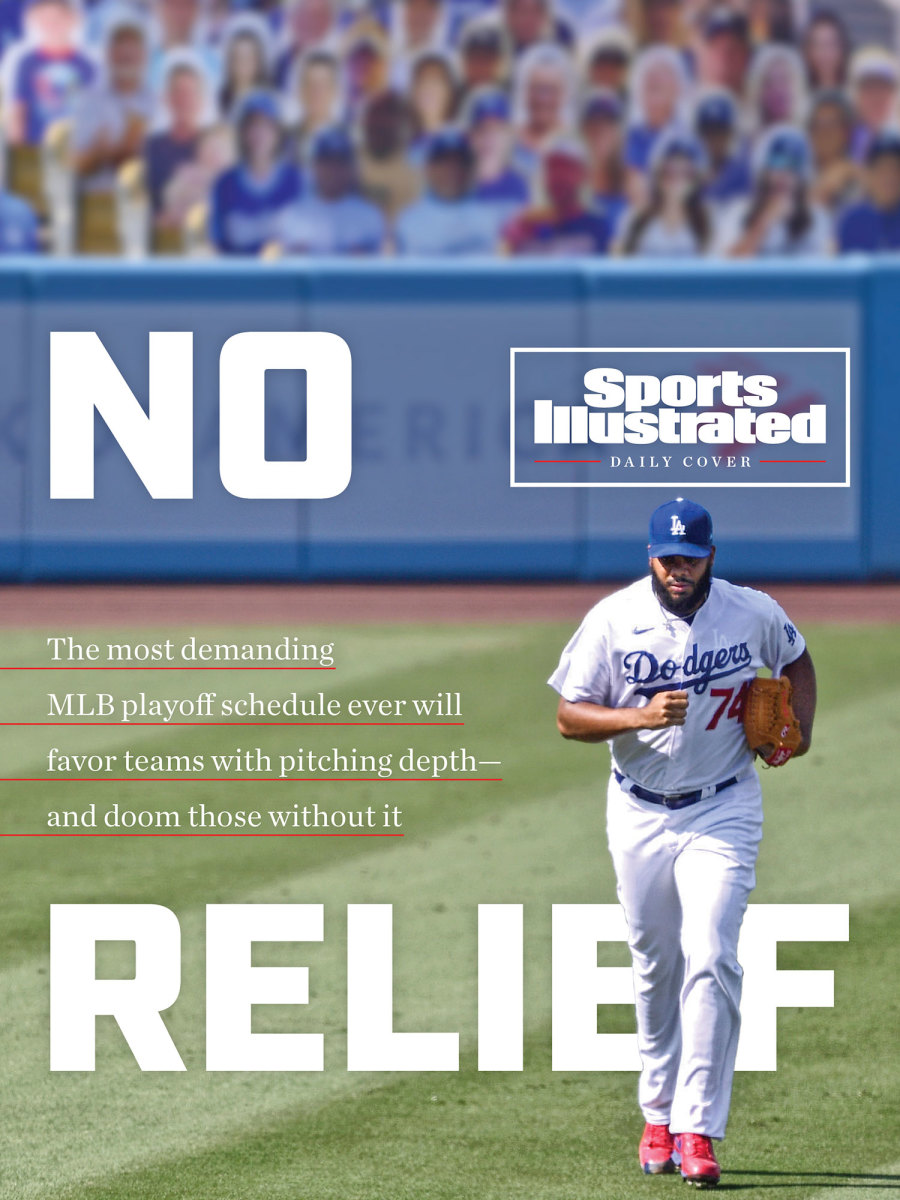Want to Win It All in 2020? You Better Have the Arms to Do It
The decision tree for Tampa Bay manager Kevin Cash is as robust as a hundred-year elm. He has a sturdy limb on which to climb in every direction.
Need someone to get out a pocket of left-handed hitters? Cash has Aaron Loup (.212 batting average against by lefties), reverse-platoon split specialist Oliver Drake (.200) and lefty Ryan Sherriff (.154). How about right-handed hitters in key spots? Aaron Slegers (.175) and Diego Castillo (.164) to the rescue. Any hitter vulnerable to a good slider? John Curtiss (.190) and Pete Fairbanks (.185) are on call. A spot where a strikeout is needed? Just let Nick Anderson throw his wicked four-seam fastball (.097, including no hits on the 50 times he threw it above the belt).
Such depth in bullpen options always plays well in October baseball, but never more so than in this postseason. The team that wins the World Series this year will need a record 13 postseason wins, and to get there it must survive no off days during the Wild Card Series, the Division Series and League Championship Series–maximums of three, five and seven games without a day off.

In a season in which starters pitched only 55.5% of the innings, made most of their starts on five days or more of rest and reached 120 pitches only once in 1,796 starts (St. Louis right-hander Adam Wainwright), pitching depth will be more important than ever before.
Before last postseason I told you that October baseball would pivot on home runs, given the record amount of dingers and the difficulty of stringing hits together last regular season. The Nationals became champions because of such quick strikes. Six outs away from being eliminated against Clayton Kershaw and eight outs away from elimination against Zack Greinke, Washington flipped games against Cy Young winners on home runs by Anthony Rendon twice and once by Juan Soto. Home runs by Howie Kendrick were game-winners in both cases, NLDS Game 5 and World Series Game 7.
This postseason will pivot on high leverage pitching decisions. Managers are under the microscope. The condensed schedule will force them to use second-tier bullpen options with the game on the line, not just the two or three top arms at the back of the bullpen.
The advantage swings to teams with managers who trust the most relievers in high leverage spots. Advantage: Rays, Dodgers and Padres.
To understand this concept you must understand how the game has changed. Teams have hacked the traditional first-inning pitching troubles because of finely detailed scouting reports and by encouraging starters to attack lineups like relief pitchers–holding nothing back. Jacob deGrom, for instance, averaged 99.3 mph on his four-seamer in the first inning, the highest of any of his innings.
What every year has been the inning with the highest ERA is now lower than four other innings. It always made sense; the only inning guaranteed to have lineups maximized for run production. The biggest trouble spots are now, in order, the third, fourth, sixth and fifth innings.

Now imagine you are managing a postseason game and a leadoff walk in the middle innings carries the nervous energy of a rally. Do you trust a starter who rarely has pitched deep into games this year? Do you start dipping into your bullpen depth–but this year knowing you might be facing three, five or seven games in a row?
“The pressure point on a manager comes quickly in the postseason,” said one recent former manager. “It’s hard to describe the pressure you feel to do everything you can not to let a postseason game get away. That’s why you see most managers go quickly to their bullpens. It’s going to be especially true this year.”
Hitters are peculiar creatures. They actually hit better in high leverage situations (.252) than in low leverage ones (.241). Give them a reason to focus more and they raise their game. Controlling those situations from a pitching standpoint is paramount. And in today’s game, especially this postseason, you must have more than two or three good options to do so.
How good is Tampa Bay at solving that riddle? First a short-term look: here are the toughest pitching staffs to hit in high leverage spots this year:
Lowest Batting Average Allowed in High Leverage, 2020
Avg. | |
|---|---|
.208 | |
2. Chicago Cubs | .211 |
.218 | |
.220 | |
.227 |
Lowest Batting Average Allowed in High Leverage, Since 1969
Avg. | Outcome | |
|---|---|---|
T1. 2020 Rays | .208 | ? |
T1. 2017 Dodgers | .208 | Lost World Series |
3. 2015 Cardinals | .210 | Lost NLDS |
4. 2020 Cubs | .211 | ? |
5. 2016 Cubs | .212 | Won World Series |
Now that’s impressive. The Rays are the toughest staff to hit in high leverage spots since divisional play began 51 years ago.
In the late innings, Tampa Bay and Los Angeles also excel at tamping offense. The adjusted OPS (relative to the league) allowed by the Rays and Dodgers from the seventh through ninth innings are among the best ever.
Lowest OPS Against Relative to League Split, Innings 7-9
OPS+ | |
|---|---|
T1. 1990 A's | 60 |
T1. 2003 Dodgers | 60 |
3. 2020 Dodgers | 63 |
4. 2011 Mariners | 64 |
5. 1967 White Sox | 65 |
6. 2020 Rays | 67 |
Now you begin to get an idea of how the Rays and Dodgers have hacked pandemic baseball: load up on as many reliable arms as possible. This isn’t 2014-15, when the Royals lined up Kelvin Herrera, Wade Davis and Greg Holland to pitch the seventh, eighth and ninth innings. It’s not last year, when the Nationals enjoyed 13 days off in a 30-day postseason. Now you need a Swiss Army Knife bullpen: the right tool for the right job, regardless of inning, and you better have six or seven of them, not three.
Here’s one last look at these new ground rules of the postseason. Traditionally, the more pitchers you use in a ballgame the more trouble you’re in. That’s still somewhat true in 2020. When teams use five pitchers or more, their winning percentage is only .473. But 10 years ago, it was .446. Twenty years ago, it was .388.
Teams like the Rays have turned using more pitchers into a benefit. Tampa Bay was 27-8 when it used five or more pitchers, and only 13-12 when it used four or fewer.
Highest Win Percentage When Using 5+ Pitchers, 2020
W-L | Pct. | |
|---|---|---|
1. Rays | 27-8 | .771 |
2. Dodgers | 29-10 | .744 |
3. A's | 14-5 | .737 |
4. Padres | 20-11 | .645 |
5. Twins | 16-12 | .571 |
MLB Average | N/A | .473 |
Thirty-one percent of postseason games the past decade were lost by the bullpen, up from 28% in the previous decade. Like Cash, Dodgers manager Dave Roberts has a plethora of choices with the game on the line. Adam Kolarek and Victor González neutralize lefties. Pedro Báez, Blake Treinin and Jake McGee can be deployed any time. Tony Gonsolin and Julio Urías are shutdown rovers when they are not starting. Kenley Jansen has been improved as the back-end option.
San Diego manager Jayce Tingler might not have as many choices as Cash and Roberts, but he still has enough to start matching up in the middle innings without worrying about fatiguing his pen: Drew Pomeranz, Emilio Pagán, Matt Strahm, Dan Altavilla and Trevor Rosenthal all allow a batting average of .200 or less.
This postseason is unlike all others. It’s not just the empty and/or neutral ballparks or the 16 participants or the best-of-three first round, all of which make this postseason primed for upsets. It’s also unlike all others because of the games played on consecutive days. It is a month that will test the depth of pitching staffs, and the decision-making of every manager.
